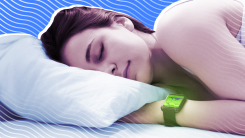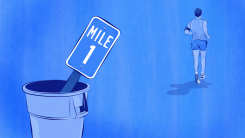The Best Fitness Trackers for Sleep and Recovery

This post is part of Find Your Fit Tech, Lifehacker’s fitness wearables buying guide. I’m asking the tough questions about whether wearables can really improve your health, how to find the right one for you, and how to make the most of the data wearables can offer.
A fitness tracker’s job isn’t done when you finish your workout, or even when you take your last steps of the day. There are devices that excel at tracking how long and how well you slept, and devices that attempt to tell you when you’re well-recovered and ready for your next challenge. Here are my picks for the best of this category.
What to look for in a sleep/recovery tracker
Where our other buyers’ guides are almost entirely about which smartwatch to pick, the recovery-oriented devices are different. Some come in the form of a watch, but the two standouts in this category—the Oura ring and the Whoop band—aren’t watches at all. Neither has a screen for you to look at; they merely gather data and present their conclusions in a smartphone app. They also aren’t (necessarily) worn on the wrist. That’s great news for people who want something minimalist and distraction-free. But that’s not everyone. Here are the questions to ask yourself when you’re shopping around.
Do you want a sleep tracker, or a smartwatch that can track sleep?
Before you start looking at sleep-specific devices, it’s important to ask yourself whether you want sleep tracking as a feature of a device that does other stuff, or if you truly want a device that’s dedicated to sleep and recovery tracking.
Most general-purpose smartwatches can do adequate sleep tracking. They’ll give you a decent idea of how late you went to bed, how many hours of sleep you tend to get, and they’ll often report some recovery metrics as well, like your resting heart rate. (Even my old Series 4 Apple Watch with its less-than-24-hour battery life can track your sleep times and resting heart rate. Just charge it while you shower.)
I’ll include a smartwatch or two below, but if you really want a smartwatch, check out our other guides for health tracking and for running. You may find the watch you really want in one of those categories.
Are you OK with paying for a subscription?
My two top picks both require a subscription to make the most of your data. Whoop sells the subscription as their primary product, with the band as a thing they throw in to go with it. Oura, meanwhile, will sell you a ring and give you sleep and recovery scores for free; but to get the detailed information you probably came for, you’ll need to pay up.
Do you need accurate activity tracking?
All of these wearables say they can track your heart rate during exercise, but that doesn’t mean they do it well.
Oura’s niche use as a sleep tracker evolved from the fact that it’s really hard to get accurate heart rate data from a ring while you’re moving. (Longtime readers will recall that I reviewed the Motiv ring in 2018, and found that it was useless for exercise, but great as a sleep tracker.) Oura turned its ring’s weakness into a strength: Since it needs you to be very still and quiet to take readings, they positioned it as a sleep tracker, which needs to do that exact thing really well.
But that means that when they added activity tracking later on…well, it’s not great. It’s better than I would have expected, to be sure. But it would definitely not be my choice for tracking exercise. I wear an Oura ring every day, but I’ll actually strap on a watch when it’s time to go for a run.
Whoop does a better job than Oura, but it still has its issues. I’ve found it can easily get confused about my actual heart rate; the numbers will seem low, and then I’ll wiggle the band, and suddenly I’m seeing a 160 heart rate instead of 140. That’s a pretty big margin of error. Many people find that the Whoop is good enough, most of the time, but if you need really accurate exercise metrics you’ll probably be happier with a more traditional fitness tracker instead.
The best sleep and recovery trackers for every need
Best for minimalists: the Oura ring ($299)
This one is my personal favorite; I fell in love with the Oura ring when I reviewed it years ago. If you hate wearing wristwatches and don’t really care about activity tracking, this is the device for you.
The Oura gives accurate resting heart rate (RHR) and heart rate variability (HRV), two metrics that come more or less directly from its sensors, with minimal layers of interpretation. Both can tell you something about your stress and fatigue levels. Generally, if you’re well-rested and not under too much stress, your RHR will be low and your HRV will be high. I routinely see an elevated RHR if I’m sick, if I’ve been drinking or staying up late, or if my weightlifting training has been putting a lot of stress on me. On the flip side, RHR can lower over time as you improve your cardio fitness.
Oura’s app then uses those metrics, and other data it’s collected about you, to give you sleep and readiness scores. The sleep score is about how long and how well you slept. The readiness score is highest when you’re under the least stress (low RHR, high HRV). But I find these scores less useful than the raw data they’re built on. An Oura ring without a subscription only provides these scores, without the raw data. It’s not worth it.
Oura is supposed to be the best wearable for tracking sleep stages, and that may be true, but no wearable is actually tracking your sleep stages accurately. Pay more attention to your total sleep time, which it’s relatively good at detecting, not the time in each stage or the overall sleep quality.
One more, important note about activity tracking: you will not want to wear this during workouts where you’re lifting weights or hanging from a pullup bar. The ring is chunky enough it will interfere with your grip and dig into your skin. You won’t be able to do your best lifts while you’re wearing it. And if you care about the ring’s appearance, lifting weights will definitely scratch it up. I lift a lot, so I leave my ring on the charger when I head to the gym.
So if you can’t lift in it, and it’s not great at activity tracking or sleep staging, why wear one? Honestly, because I can forget that it exists, and still get all the benefits of knowing what my RHR and HRV have been, pretty much every night, for the last three and a half years. (I never stick with a wearable that long.) The metrics help me to understand whether I’m recovering well enough from my daily training, and remind me to pay a little extra attention to my sleep and stress when training gets tough.
-
Oura ring, $299 for the Heritage shape in silver, gold, black, or matte black (“stealth”). The subscription is an additional $5.99/month, with a one-month free trial when you sign up.

$299.00
at Best Buy
Best for athletes: Whoop band ($249, sorta)
If you want something that can track activities, but works with an app that is recovery-focused rather than exercise-focused, you probably want a Whoop band.
If you’re happy to strap a gadget to your wrist, great—that’s the easiest way to wear a Whoop. It will look like a watch, except with no screen (the fabric band covers the spot where the screen would be, if it had one). If you don’t want a wristband, the Whoop device can also be strapped to your arm, between your deltoid and bicep (they call it a “bicep band”). This was my favorite way to wear it.
The company also sells sports bras and other items of clothing that have a little pocket for the device. (You take the little plastic brick off its strap, then insert it into the pocket.) So even if you hate wearing a watch or you’re doing exercises that aren’t compatible with a wristband, you can still wear this during your workout.
One of Whoop’s characteristic features is that you can wear it 24/7. Instead of plugging it in to charge, there is a little detachable battery that you plug in. Then, for an hour or so every couple of days, you slide this battery onto your Whoop band like a tiny backpack. When it’s fully charged, the indicator light will change colors and you can slide it off.
Besides tracking your sleep, the Whoop can also track activity—although, as we noted above, it’s not as accurate as some of the more traditional gadgets. (If you really want the most accurate heart rate, you’ll want to get a chest strap anyway.)
The app models sleep and activity—which it calls Strain—as two sides of the same coin. If you did a long or hard workout, your Strain will be high, and the app will recommend an amount of sleep that will help you to recover. In the morning, it will tell you where your Recovery stands, and recommend an appropriate amount of Strain for the day’s workouts. As I’ve written before, I don’t think it’s very smart to adjust your long-term training plan based on short-term fluctuations in recovery, but how you use the data is up to you.
-
Whoop band, free with $30/month subscription, or $249 if you pay for the full year in advance. There is also a one month free trial that loans you a pre-owned device.

$239.00
at Amazon

Best smartwatch option: Garmin Venu 3 ($399)
All of Garmin’s running watches include recovery metrics, including the Body Battery. Like Whoop’s approach, this sees exercise and sleep as sort of opposite forces. Your Body Battery will be closer to 100% if you’ve been sleeping well and haven’t done much strenuous exercise lately. It will drain as you exercise, or if you’re under a lot of stress. Sleeping fills it back up again.
For a budget option, you can get this metric on, say, a $119 refurbished Forerunner 45. But if you’d like to buy a new smartwatch just for sleep tracking, I’d suggest the Garmin Venu 3.
The Venu 3 has the Body Battery feature, as well as a Sleep Coach that will tell you how long you slept, how that compares to how much you needed, and it will recommend how much you should try to sleep tonight. The recommendations are based mainly on your HRV (one of those recovery metrics it can read from its sensors) and your recent sleep and activity history. The Venu 3 also has nap detection, by the way, so you’ll still get credit for falling asleep watching a movie—but it also won’t confuse that with your regular night’s sleep.
-
Garmin Venu 3 ($399)

$449.99
at Amazon



